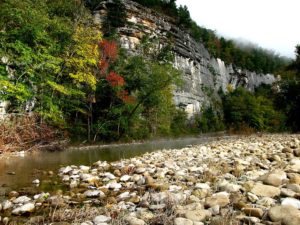calsfoundation@cals.org
An interview with Michelle West, director of First River
The Buffalo River has a history as winding as its 153-mile path. The lower 135 miles of the river, from Ponca to the White River, flow within the boundaries of an area managed by the National Park Service, where the stream is officially designated the Buffalo National River. It was designated as the nation’s first national river by Congress on March 1, 1972. The national river designation protects natural rivers from industrial uses, impoundments and other obstructions that may change the natural character of the river or disrupt the natural habitat for the flora and fauna that live in or near the river.
The Central Arkansas Library System and the Ozark Society will present a free showing of First River: How Arkansas Saved a National Treasure, a new documentary directed by Michelle West in celebration of the 50th anniversary of the Buffalo River’s designation as the country’s first national river, at CALS Ron Robinson Theater on Thursday, April 7. We caught up with West to ask a few questions before the screening.

What was your motivation to direct this?
I have been visiting the Buffalo National River for over 30 years. It’s my favorite “getaway” in the Ozarks. I have also been telling stories visually as a profession for more than 30 years. For those two things to come together was a career highlight. I was aware of the effort it took to preserve the river, but was also aware that many of the people who visit the Buffalo have no idea what it took to protect it. It was my privilege to tell that story.
What was it like filming a documentary about a river?
Logistically, it was challenging at times. Some of the locations we chose were not particularly easy to get to with our cameras and other hefty video production equipment. We even had a canoe flip on one of the shoots – with camera gear in it! There were some very long, tiring days, but the payoff was worth it. To be able to work in an environment as beautiful as the Buffalo and to be able to tell a story this meaningful was an exceptional experience and one that I will cherish for the rest of my life.
What was your favorite part?
I would say that my favorite part was when we finally locked the ending down and we had, in essence, a completed film. It was a very emotional and satisfying milestone.
What do you hope people will take away from this film?
I have seen the film (in various stages) at least 100 times and there are still parts that bring tears to my eyes. I hope it has the same impact on the audience. I hope that people realize what it took to preserve the Buffalo, that people have the power to protect a place, and that when people come together they can impact the outcome of issues that threaten natural places in Arkansas and beyond.




